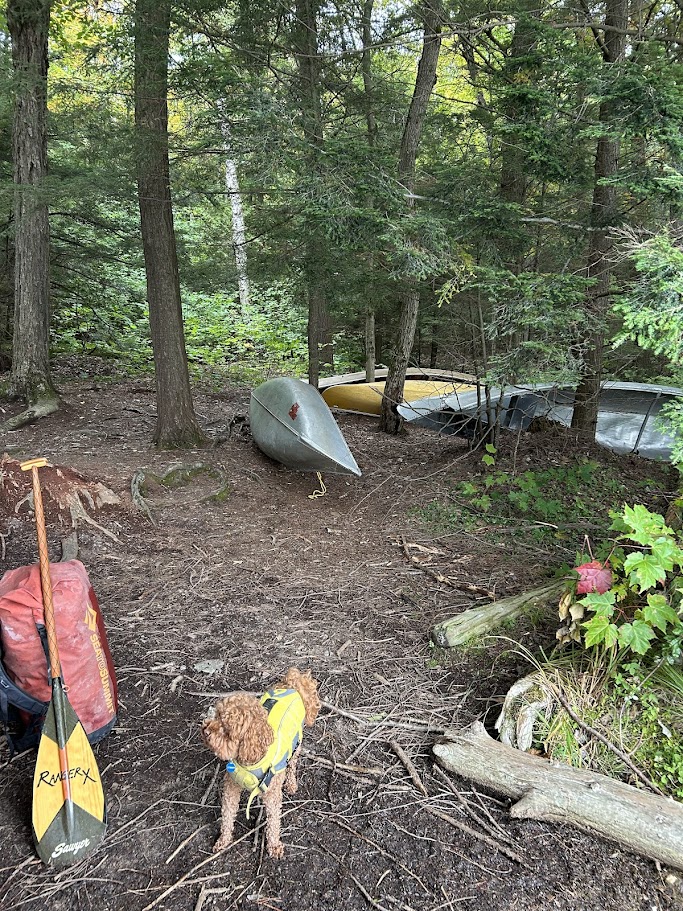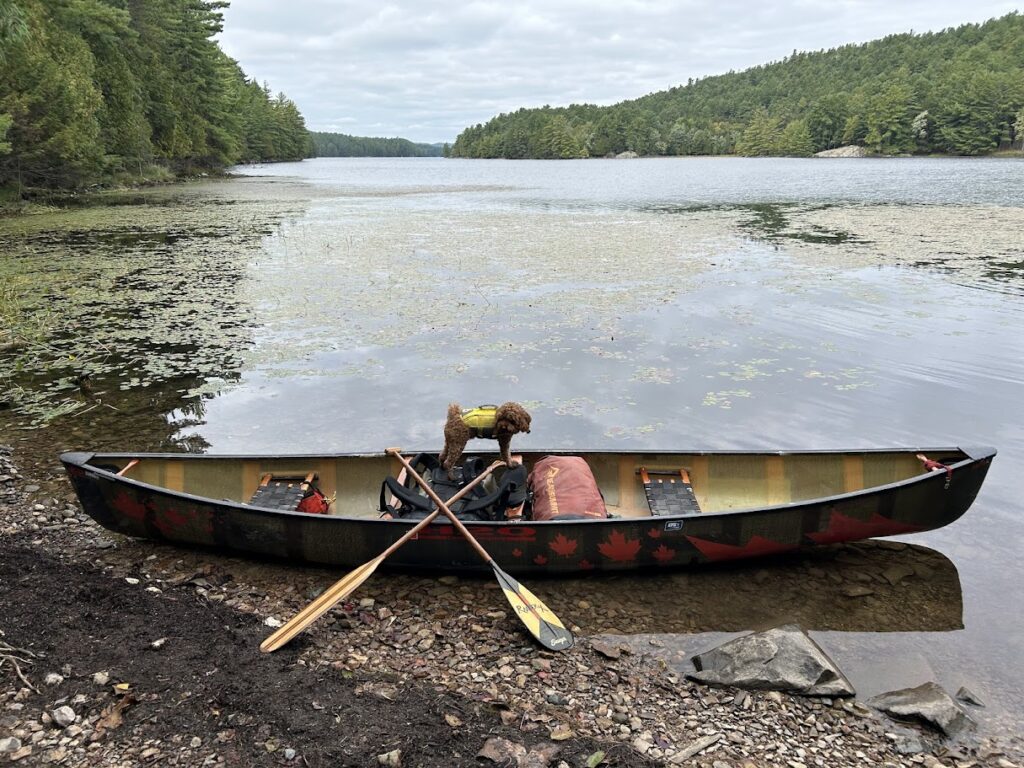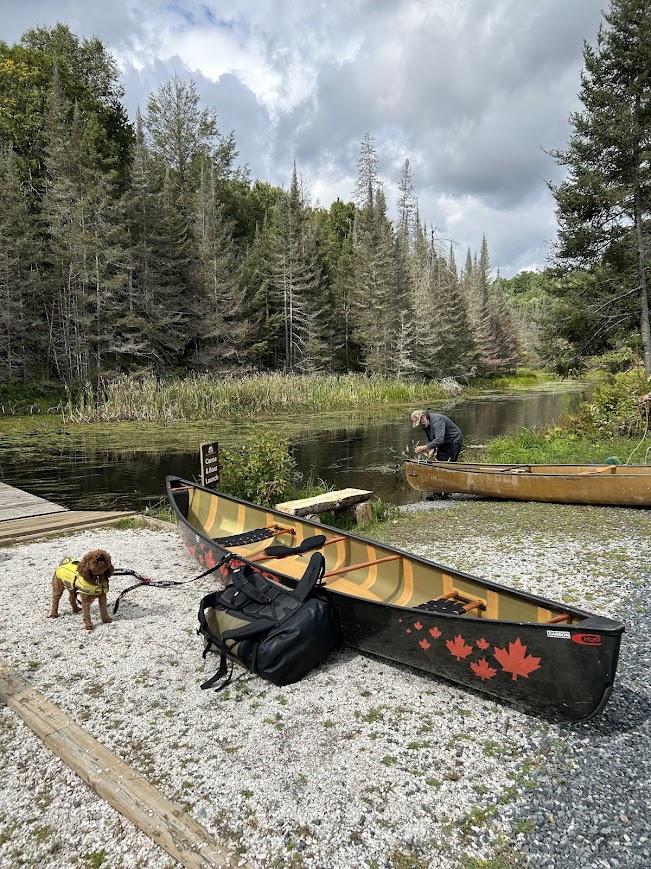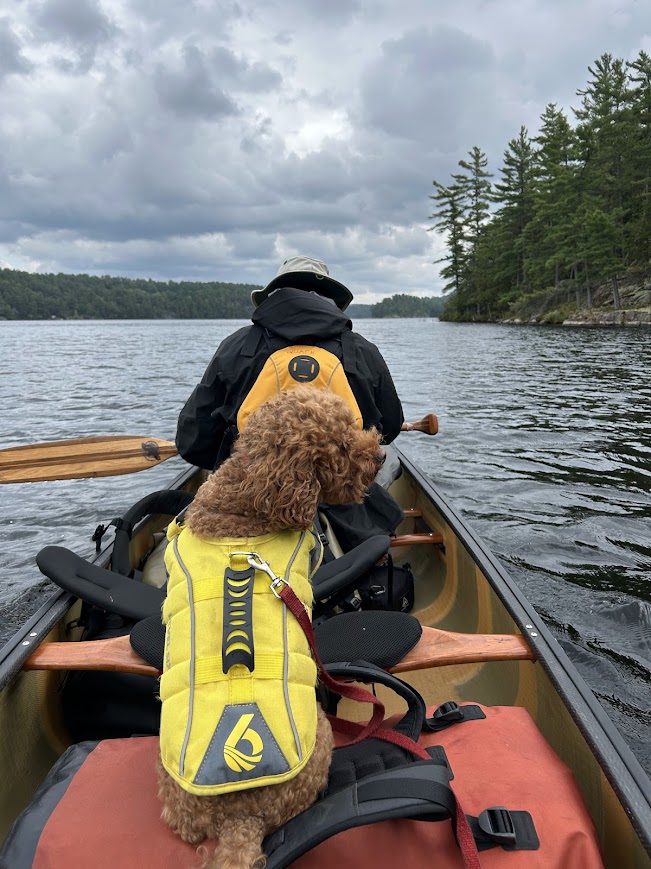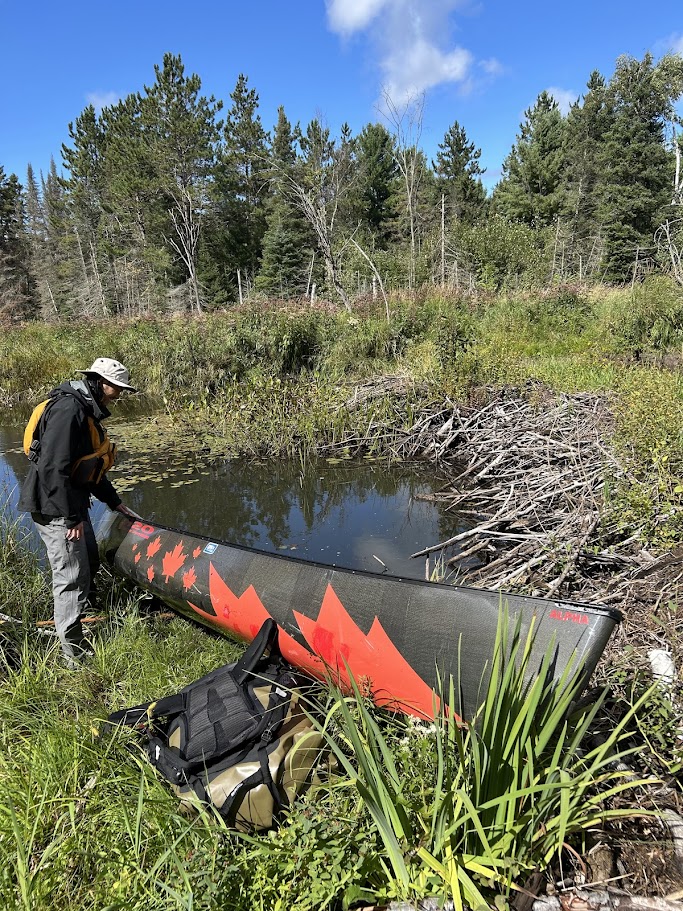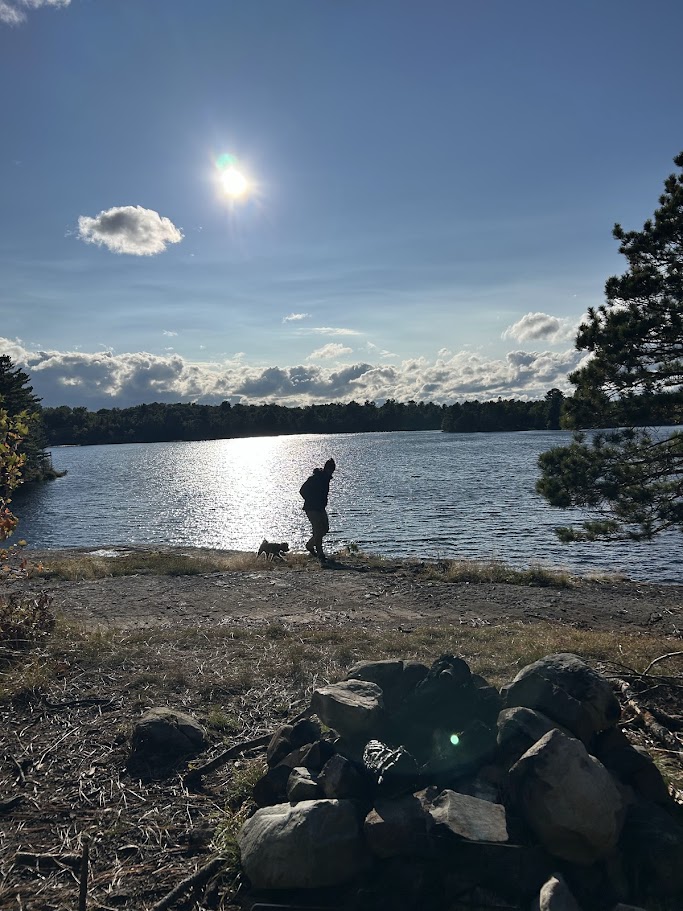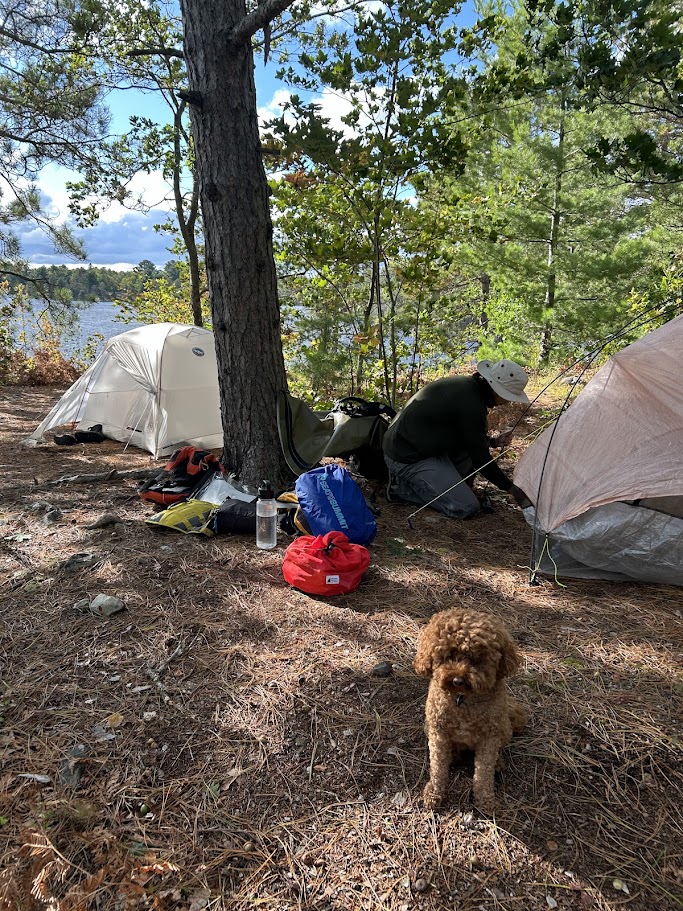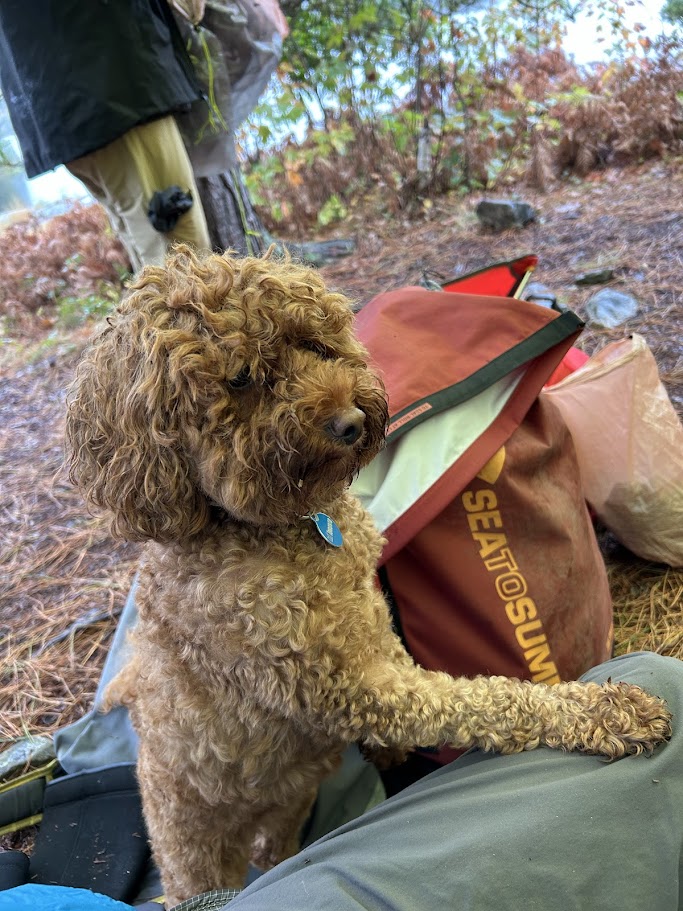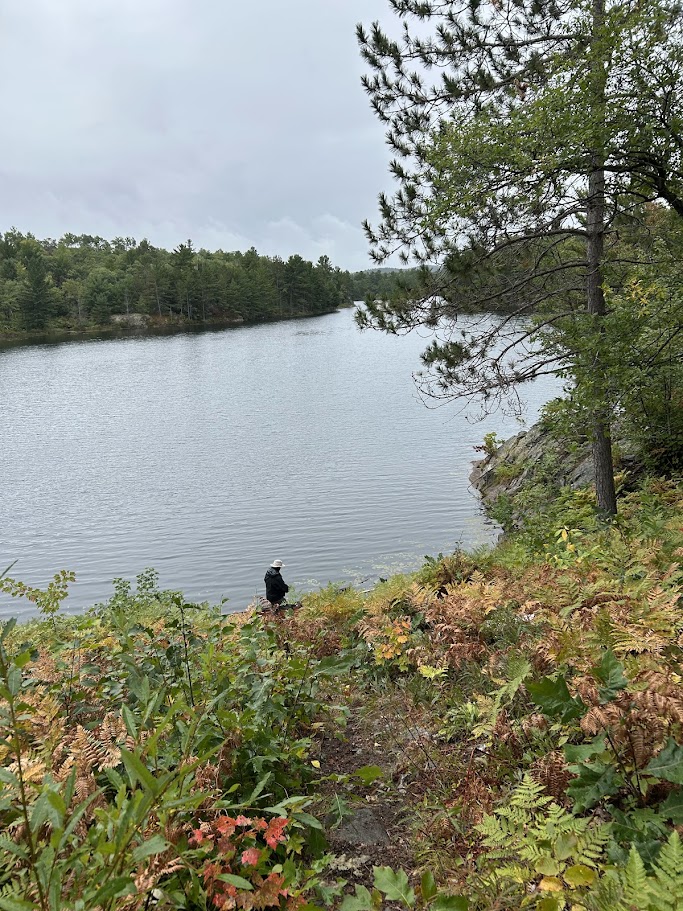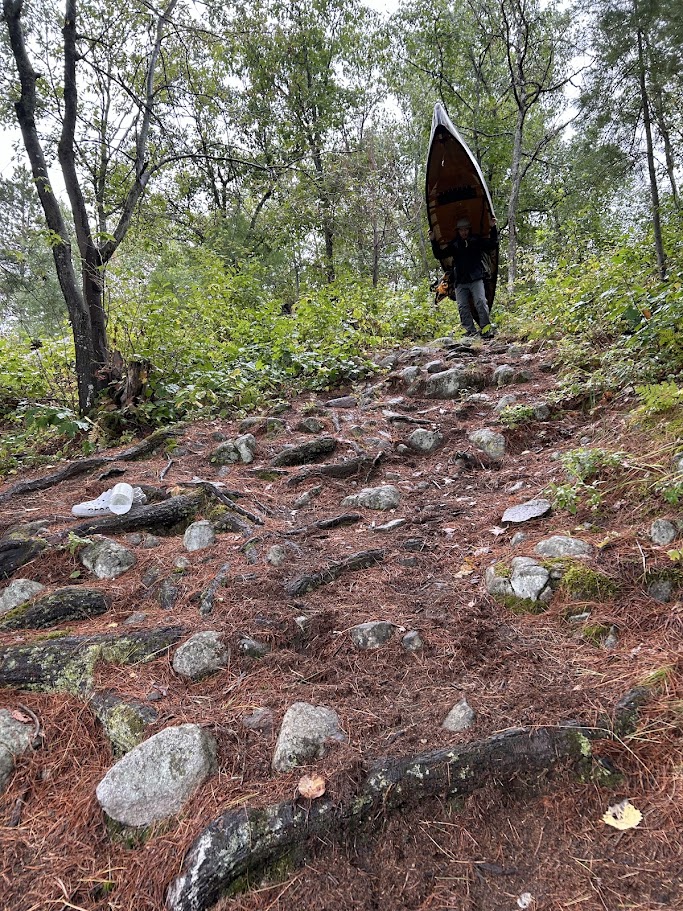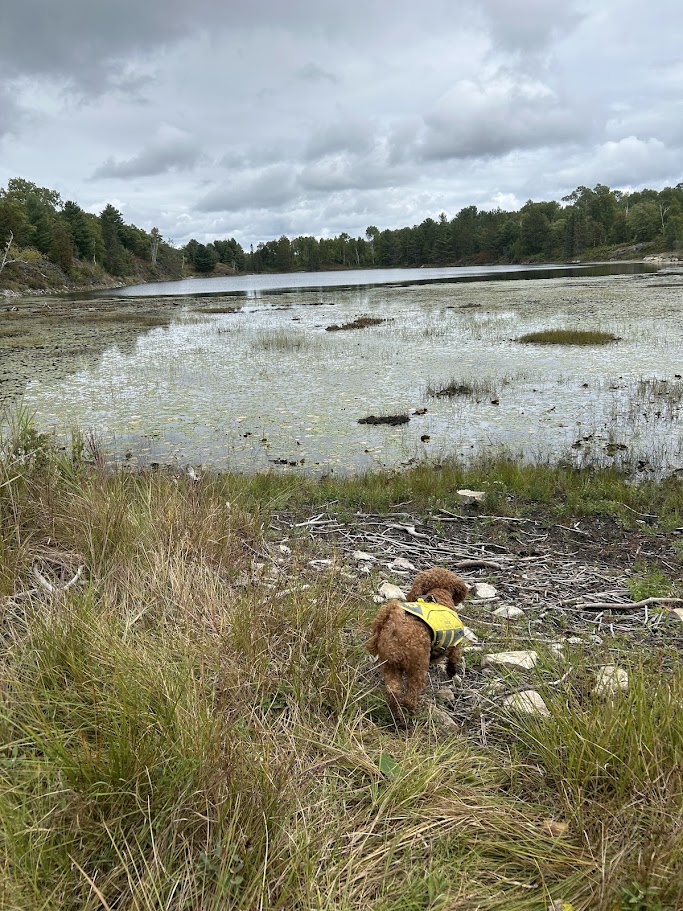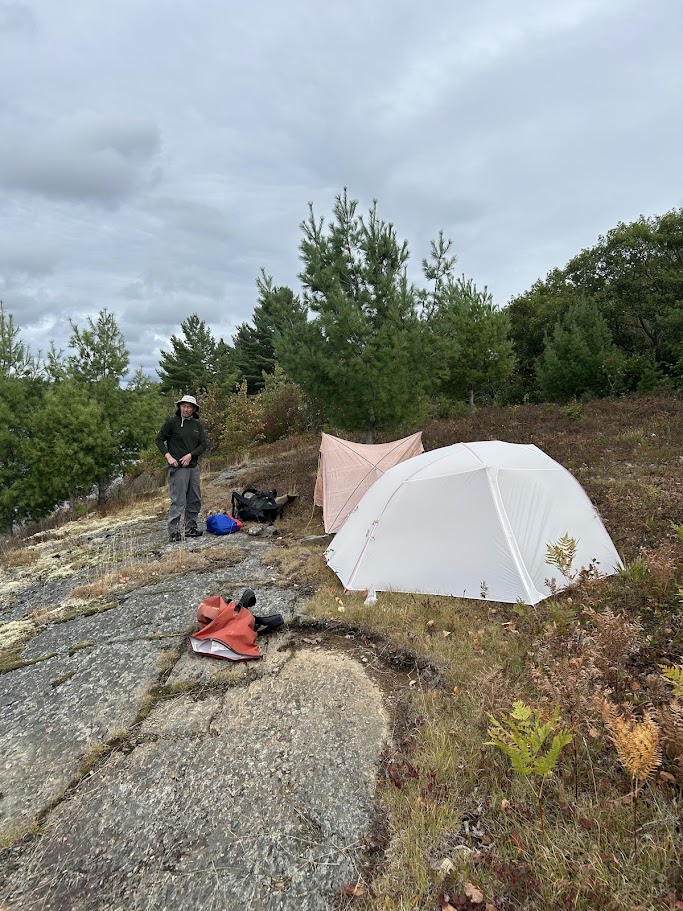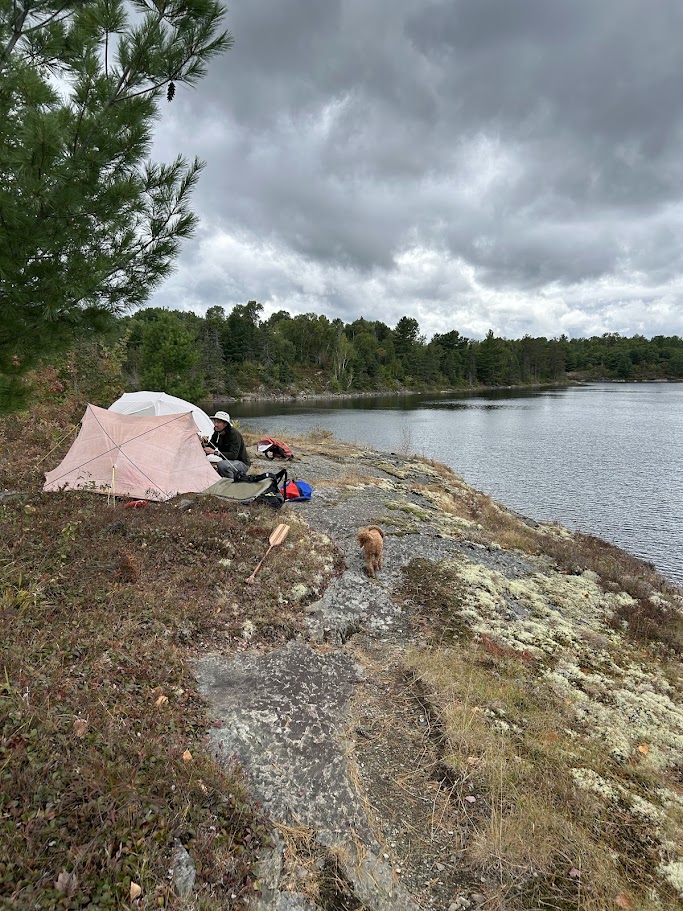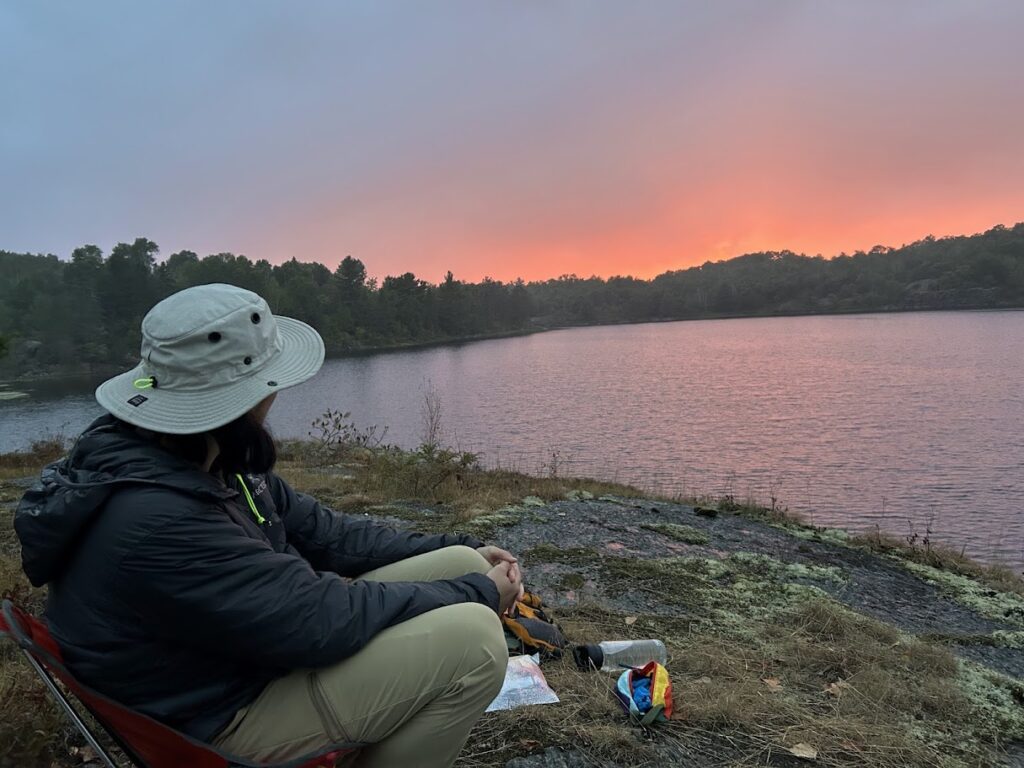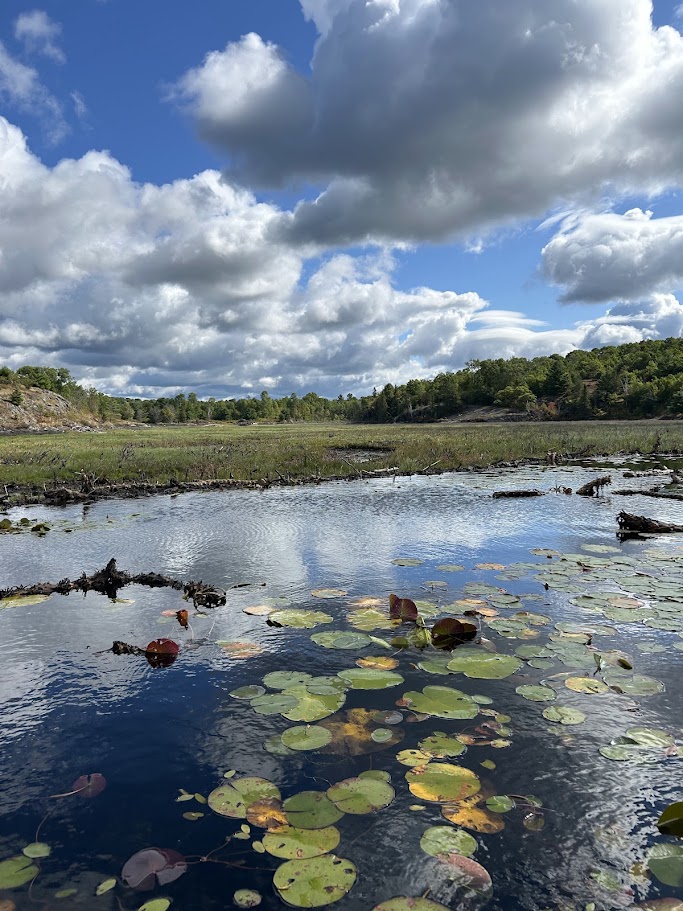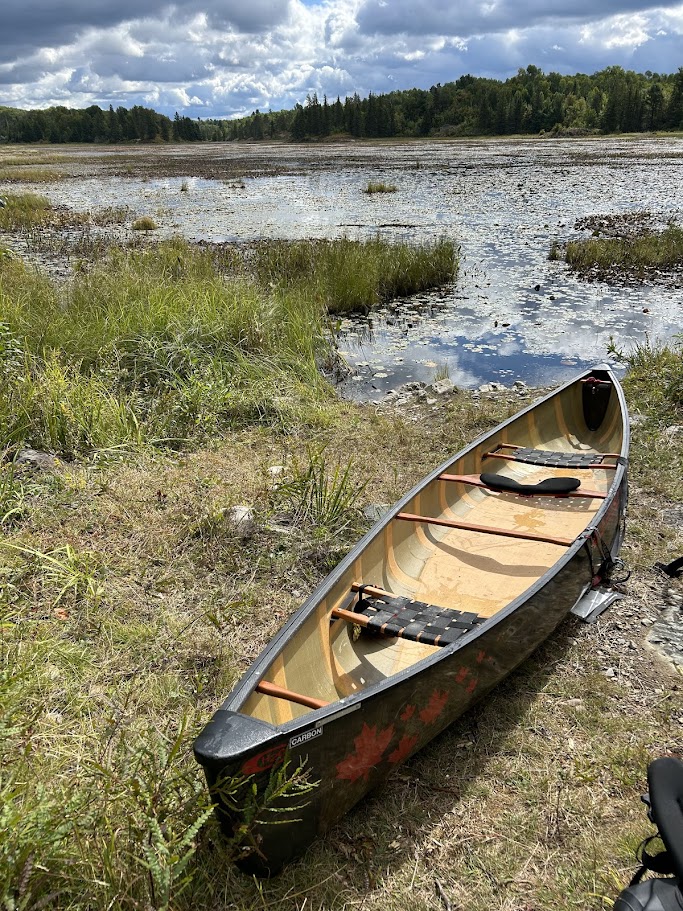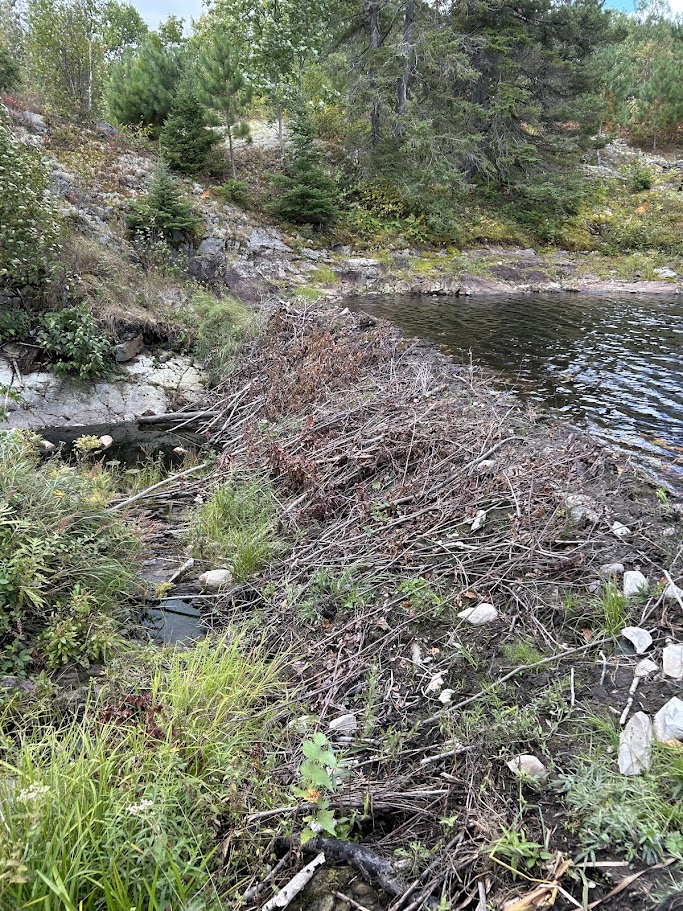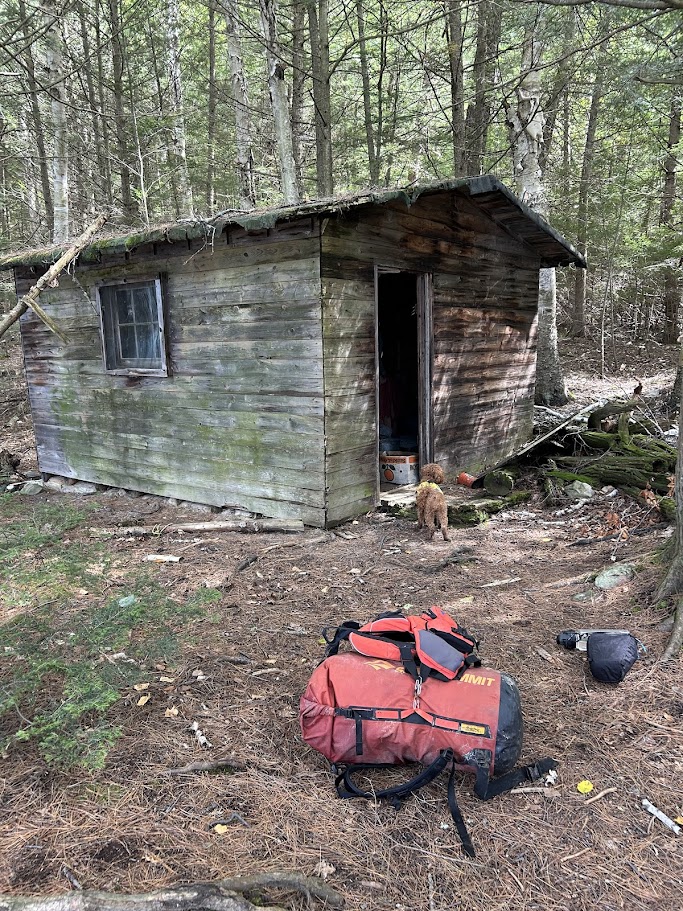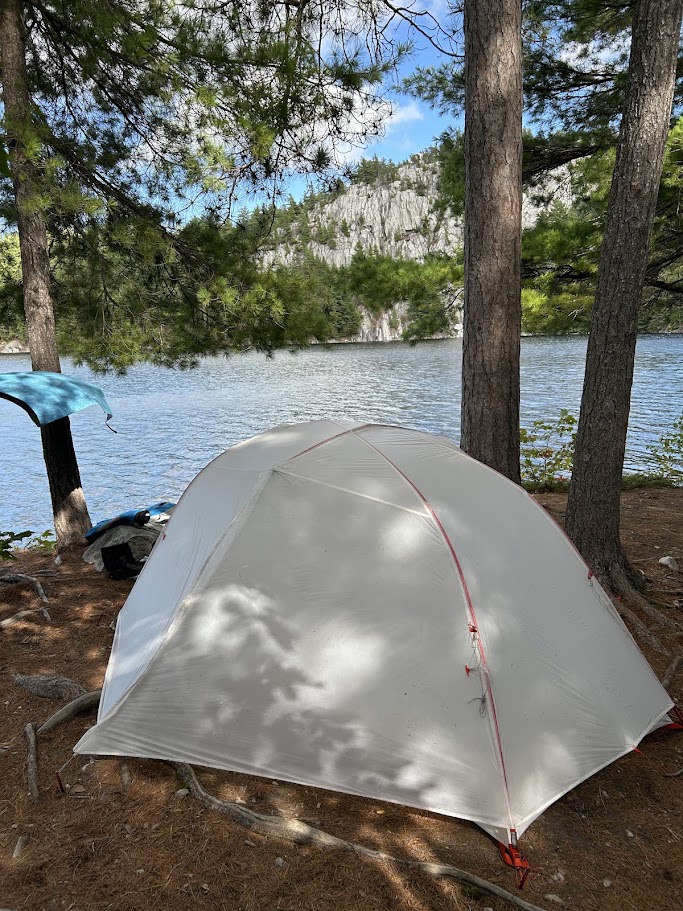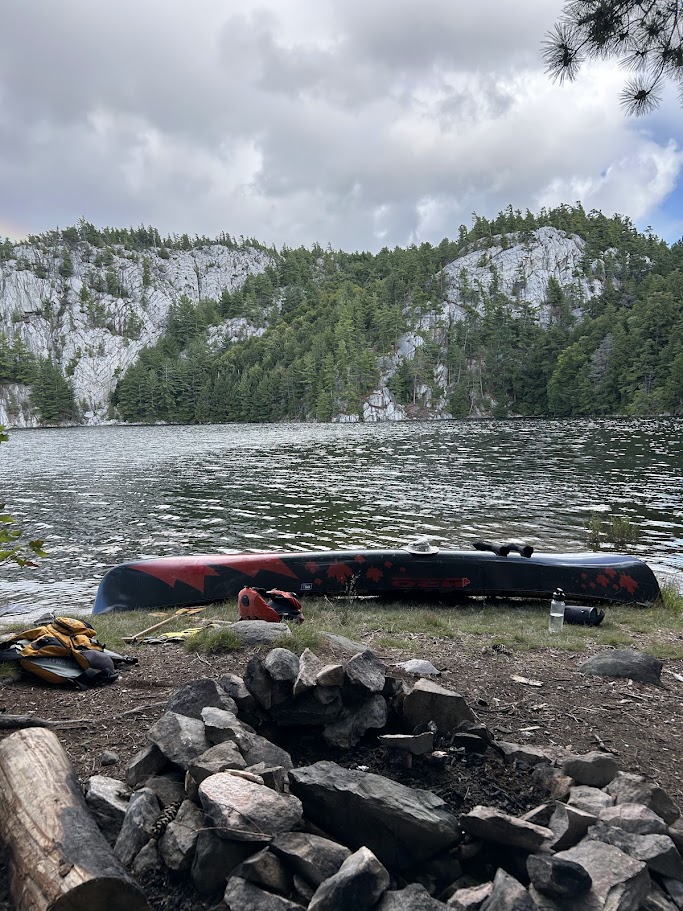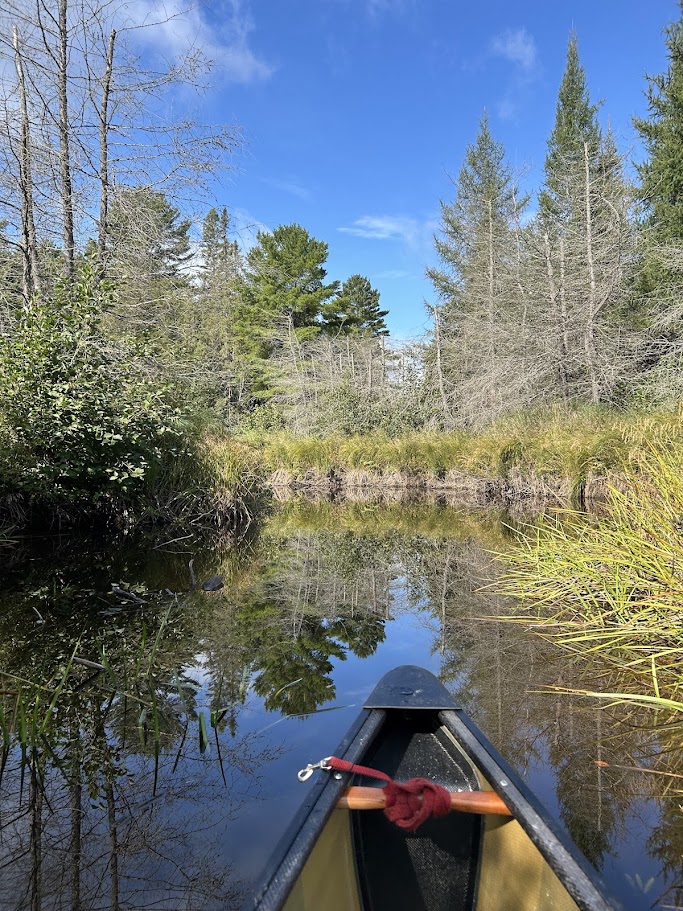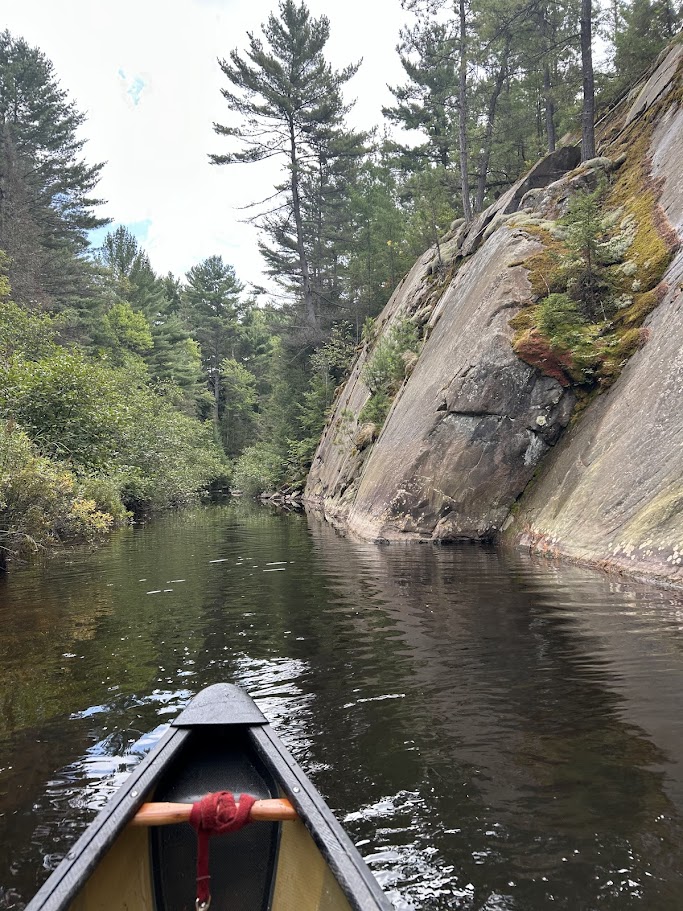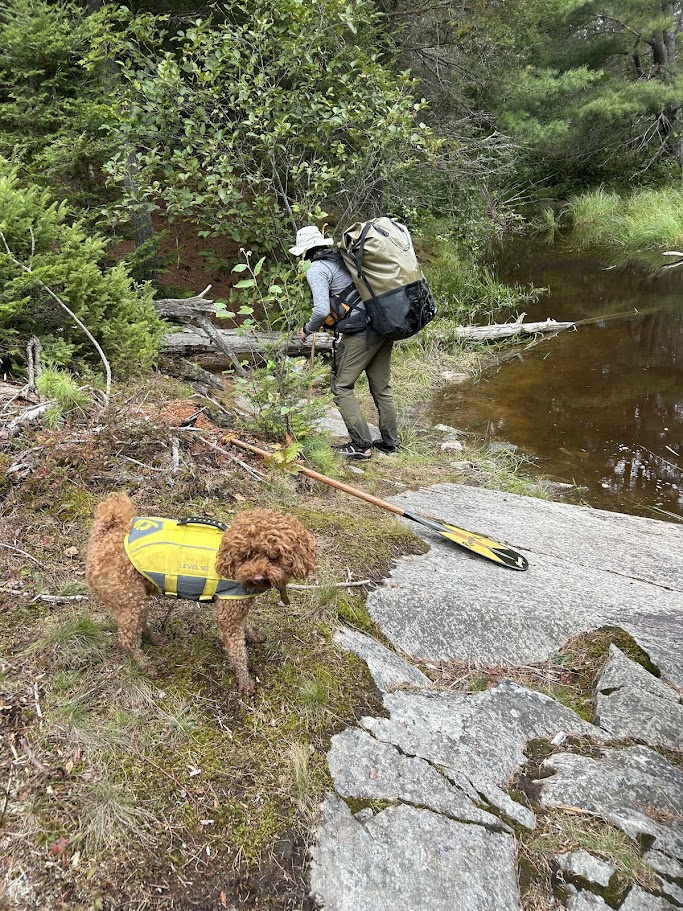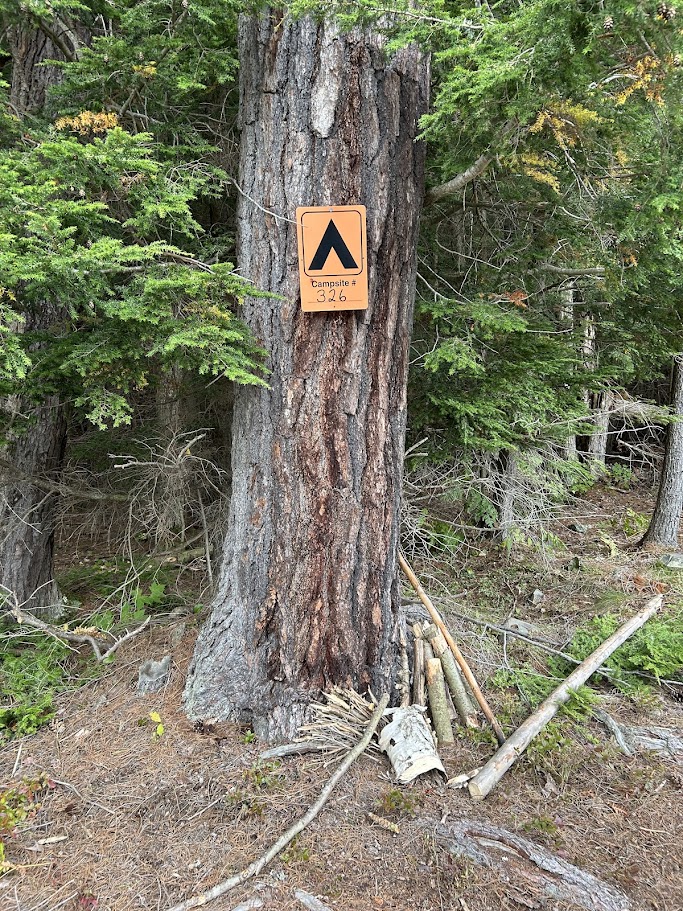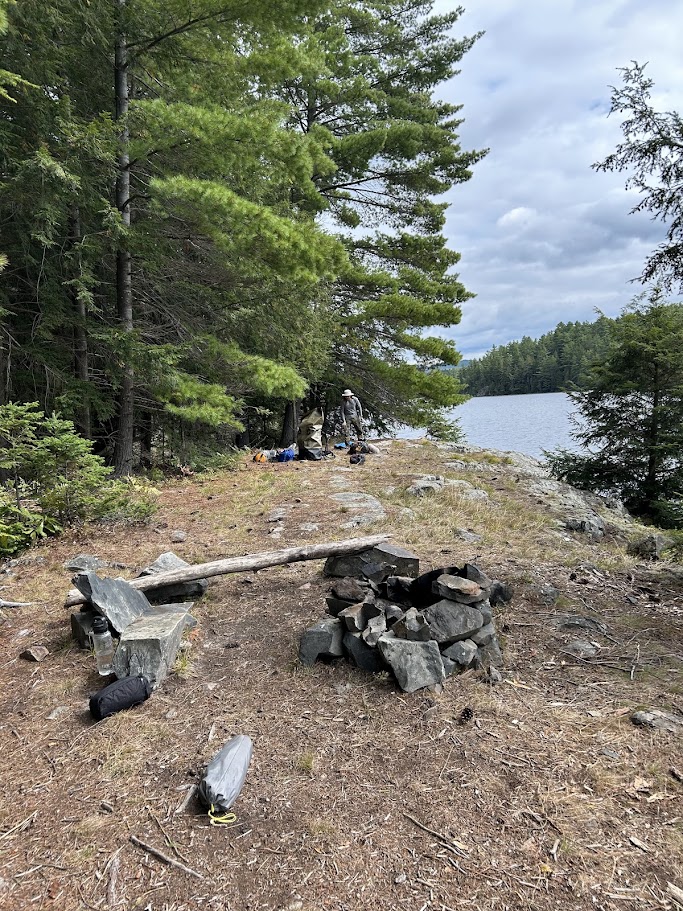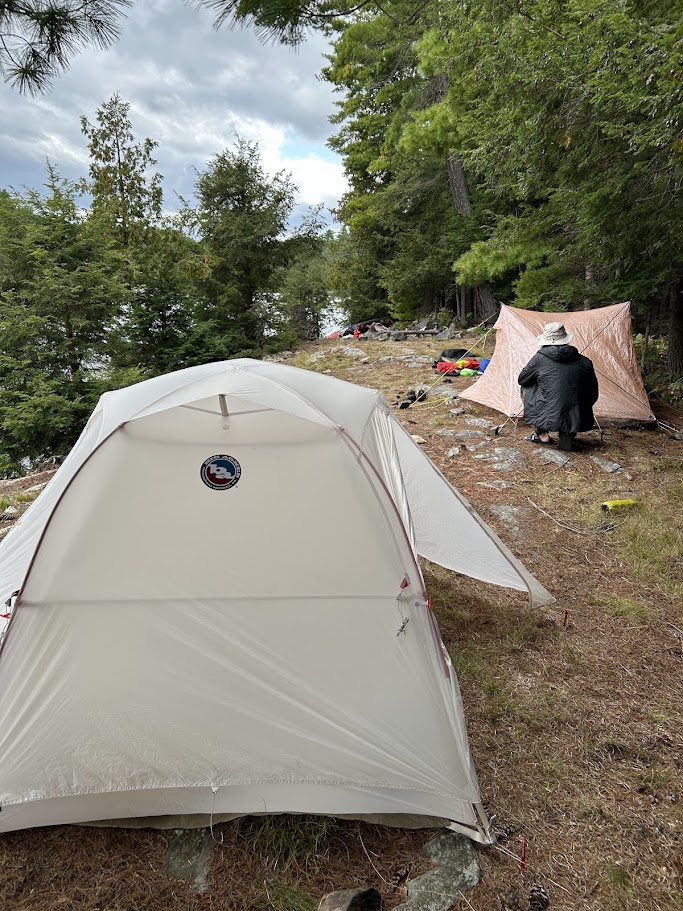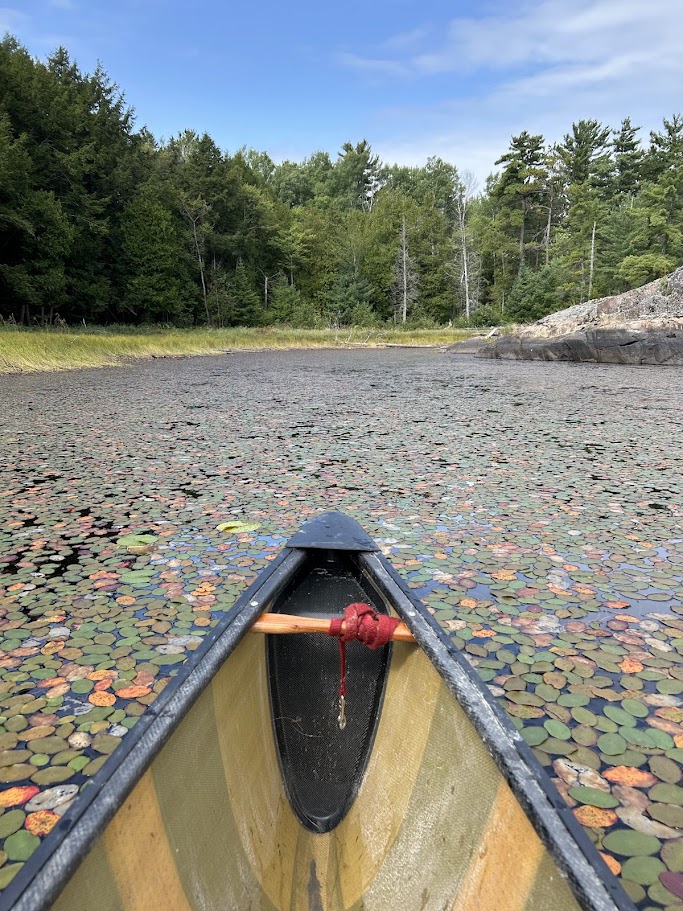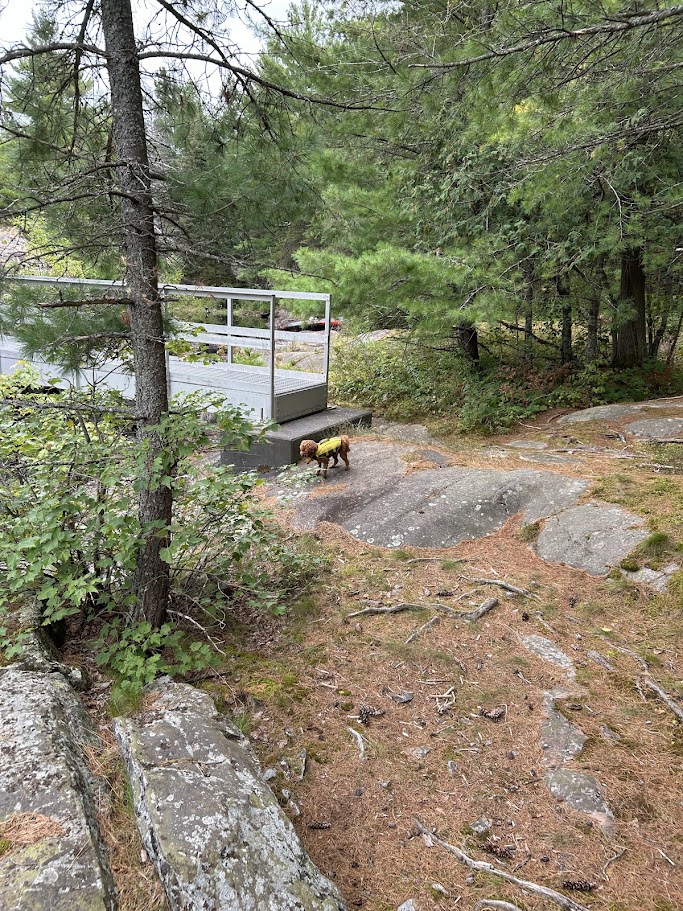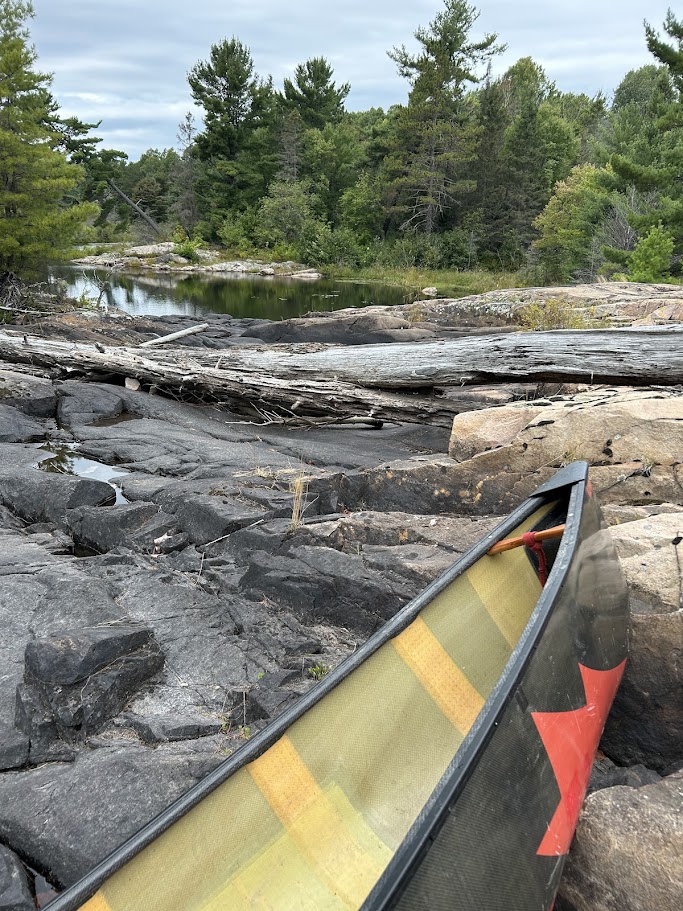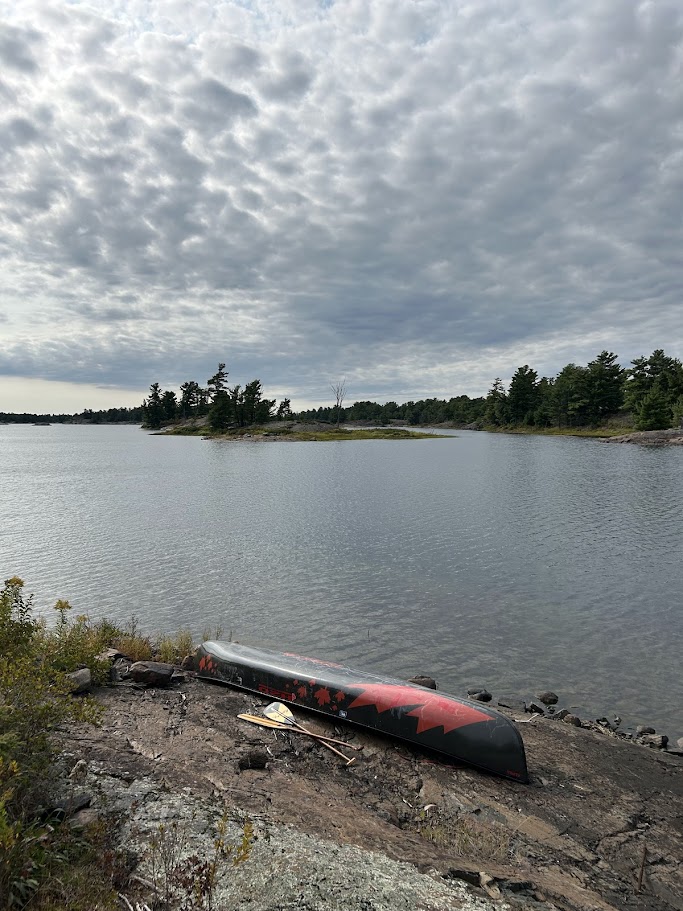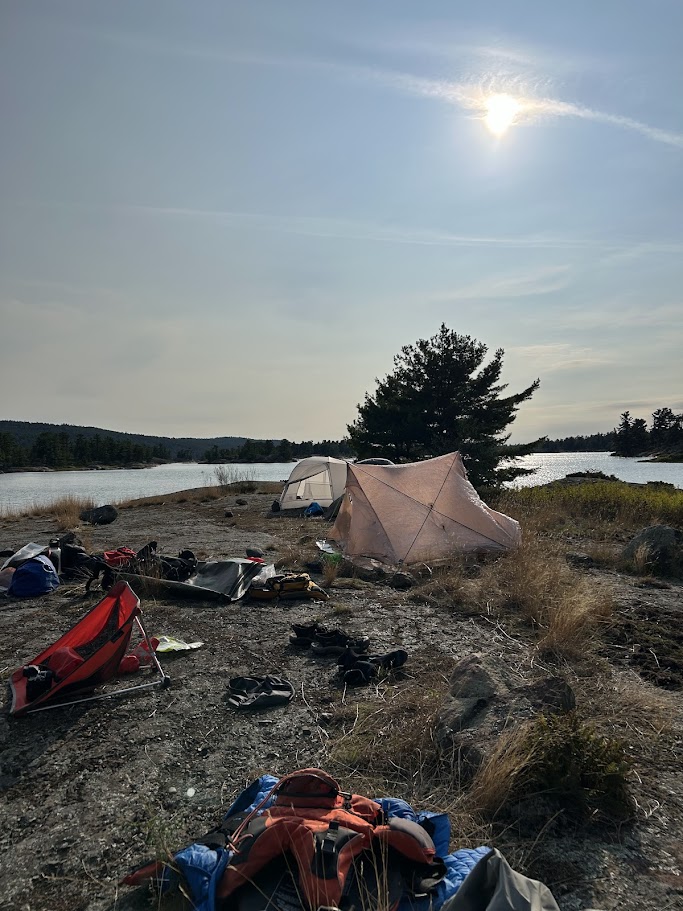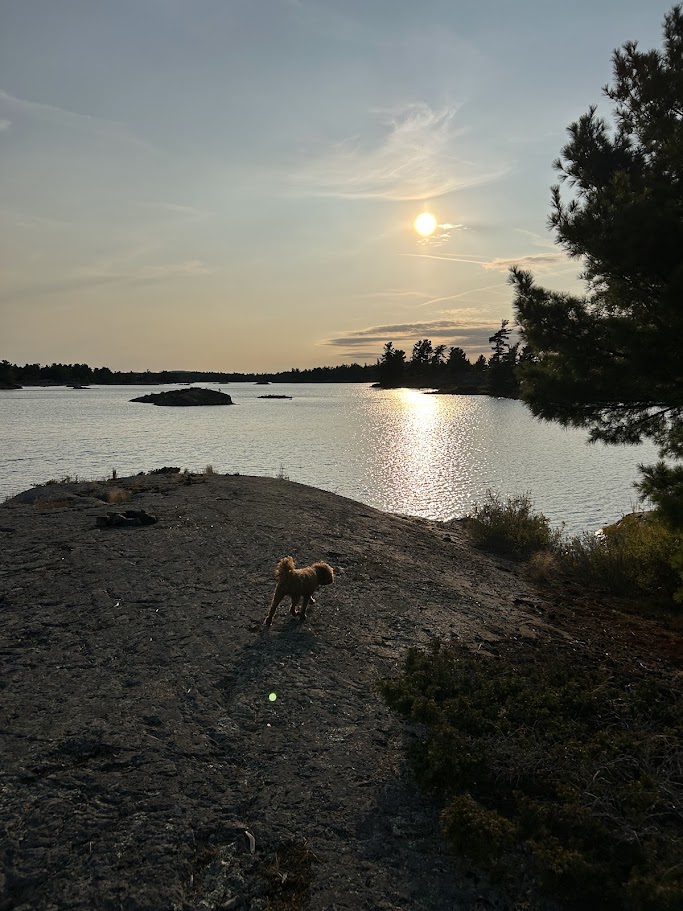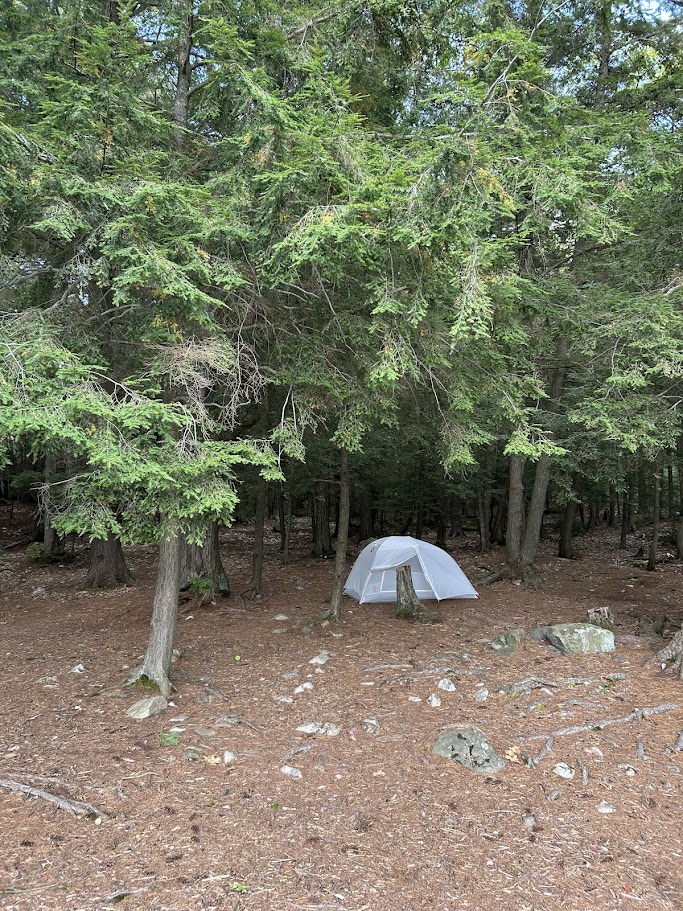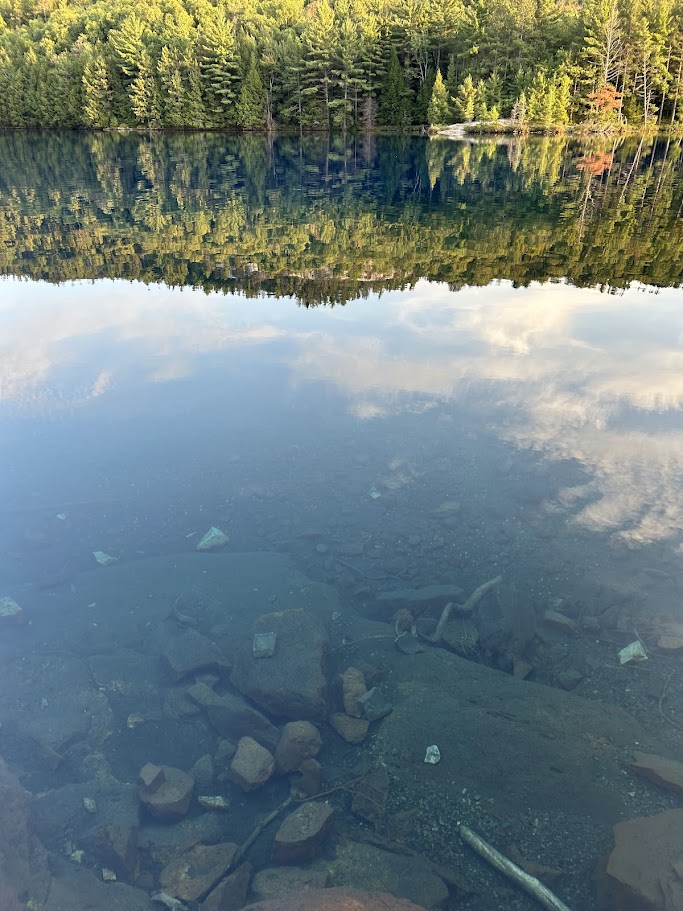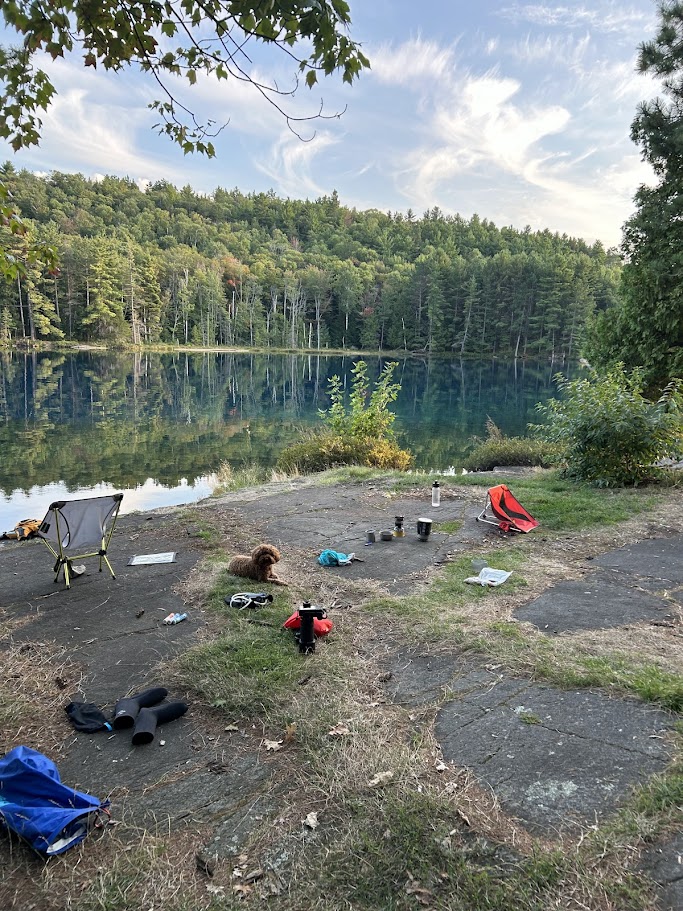Dates Completed : September 5 to 11, 2025
Total Distance Traveled : 100km Portages : 35 Total Portage Distance : 14340m
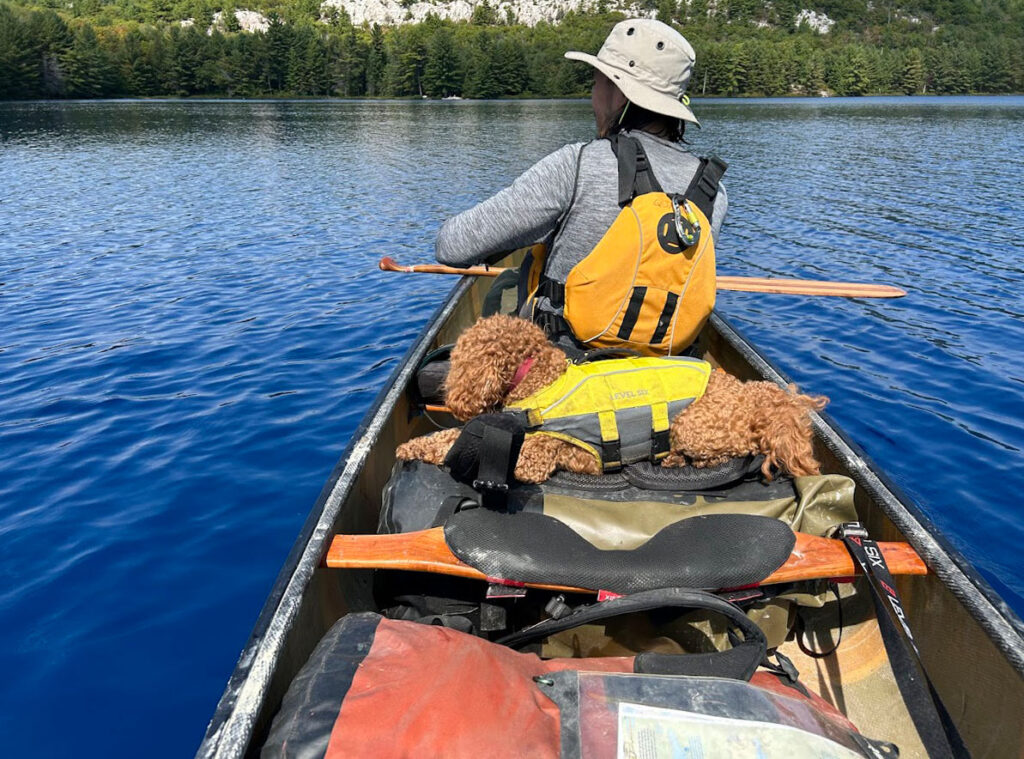
Table of Contents
Introduction
Killarney Provincial Park is known for many things: the La Cloche mountain range with its two billion year old quartzite rock, the stunning landscapes that inspired many paintings by the Group of Seven, and the crystal clear lakes where you can see down to 20m. Often referred to as the crown jewel of the Ontario parks system, it features a popular 80km backpacking loop as well as hundreds of kilometers of canoe routes and portages.
It’s also notorious for how difficult it can be to secure a campsite. The most popular lake in the park is likely Nellie Lake (for good reason) so in early April, I immediately reserved a site on that lake as soon as the five month advance booking window opened. From there, I frantically reserved the rest of the sites for my trip. I say frantically because many others clearly had the same idea – some sites disappearing right before my eyes as I browsed my maps.
Although there is no official “NW Loop” in Killarney, I simply pieced together a loop based on available campgrounds that were within a reasonable travel distance. I chose seven days since that’s the longest I’d want to go without a resupply.
This trip would consist of me, Hana the portage puppy and my friend and former colleague, Kevin.

September 5, 2025
Day 1 – Widgawa Lodge Put-In to Leech Lake (#225)
Distance Covered : 17.1km
Portages : 2 (190m, 1060m)
Total Portage Distance : 1250m
Total Time : 4:06hrs
After five months of preparation and planning, our departure date had finally arrived. As luck would have it, Killarney greeted us with an extreme wind warning – gusts of up to 70km/h were expected by late afternoon. To try and beat the worst of it, my partner and I left Toronto at 5:00am and arrived at the Widgawa Lodge put-in shortly after 11:30am. The drive took about an hour longer than reaching the southern access points, since this route went through Espanola to the northwest. And because the access point was outside of the park, we were hit with a costly parking fee of $145 – more than we paid for the actual campsites! If I knew this in advance, I probably would’ve started from the south.
Either way, the put-in at Widgawa Lodge sat on a sheltered creek, giving us a false sense of security as we departed shortly after noon.
The creek soon opened into Charlton Lake, a lake that wasn’t big enough to be truly dangerous, but large enough for the strong winds to whip into white-capped waves. At first, we enjoyed a friendly tail wind: a series of gentle nudges that quickly escalated into aggressive shoves once we passed a narrow in the lake. The skies darkened, and before long the winds picked up to a ferocious roar, hammering our backs. From the stern, I struggled to keep us aligned against the gale force winds but managed a glance behind us to see an army of whitecaps charging our way. Once they caught up to us, the canoe surged forward with the ferocity of a Polynesian war canoe charging into battle. Then came the rain – torrential sheets that would’ve soaked me to the skin if not for my drysuit. With no safe way to reach shore, our only choice was to ride it out.
Thankfully, like most storms of that intensity, it didn’t last long. Within minutes, the skies turned blue again, the sun reappeared, and the only evidence of the ordeal was a few inches of water sloshing in the canoe. Plus Hana, looking like a different dog after being completely drenched.
Big risks bring big rewards, and our reward was a highly accelerated trip to the park boundary where we were greeted by the first of many beaver dams on this trip.
One beaver dam and a short portage later, we quickly made it to Murray Lake where we completed the second portage of the day, a 1060m portage into our final lake of the day, Leech Lake. We’d be staying at the lake’s lone campsite for our first night.
In retrospect, campsite 225 was one of the best on this trip. It had a great westward view of the lake, had many flat areas for tents and was situated above a rock cliff. Normally, the exposure to wind would be a great feature for keeping the bugs away but on this day, the winds made it very difficult to set up our tents. The skies alternated from a clear blue sky to rain showers every 30 minutes or so and the temperatures dropped to single digits by night. Hana spent most of the evening shivering after being drenched but at least she received a shower and blow dry treatment I didn’t even have to pay for.

September 6, 2025
Day 2 – Leech Lake (#225) to Rocky Lake (#236)
Distance Covered : 9.9km
Portages : 5 (150m, 90m, 610m, 150m, 40m)
Total Portage Distance : 1040m
Total Time : 3:17hrs
Day 2 was the shortest of the trip. We only had about 10km to cover, which we figured would take less than four hours.
We also had two routes to choose from. Both were similar in length but the northern option had two portages while the southern had five. We chose the southern route for better shelter from the winds, which remained noticeably strong. The northern route also strayed outside of the park boundary, where we’d likely encounter cottages and motorboat traffic.
After a leisurely departure at 10:40am, we made quick work of Hanwood Lake and Wan Winkle Lake. Then came a very overgrown 610m portage, followed by a short paddle across Van Lake and Grow Lake.
Jeff’s Map warned us about a few portages which were thick with poison ivy, but we didn’t notice any – or more likely, we weren’t able to properly identify them.
A short paddle on Rocky Lake brought us to campsite 236 – our home for the night. Unlike the other campsites for this trip, this one was designated as “overgrown”, and sure enough, that were no obvious tent pads and no thunderbox.
We ended up setting up our tents on a hill overlooking Rocky Lake, right across from a portage. Two reoccurring themes during this trip were the many cottages scattered everywhere along with the boats stashed at portages. We weren’t sure why until we observed some people appear from the trail, grab a boat, and take it for a spin around the lake. We assumed that these boats were being used by the locals.
The upside of an overgrown campsite was the abundance of firewood. Within minutes, we had gathered enough driftwood for a small fire to burn our paper garbage. If it weren’t for the rain, we would’ve had a bigger one for sure.

September 7, 2025
Day 3 – Rocky Lake (#236) to Great Mountain Lake (#243)
Distance Covered : 12.5km
Portages : 6 (240m, 280m, 590m, 100m, 280m, 440m)
Total Portage Distance : 1930m
Total Time : 4:20hrs
Day 3 was another short one, bringing us deeper into the park.
On paper, the day involved just four portages, the longest only 590m. We figured it’d be similar to the previous day with maybe a few hours of travel.
Of course things rarely go as planned. Especially when it comes to river travel later into the season.
After another leisurely departure of 10:45, we paddled to the west end of Rocky Lake, where the map showed a river leading to Goose Lake. Instead, we were shocked to find the entire end of the lake had been dammed by beavers. To make things worse, the river beyond it was reduced to a trickle which would require dragging a fully loaded canoe through thigh deep mud for half a kilometer. The kind of type 3 fun that could end a trip early.
Thankfully, we knew there was a portage across from our previous campground which offered an alternate route. It added a few kilometers and two extra portages to the day, but it seemed like the better option – at least until we faced the next surprise.
Upon completing the two extra portages that reconnected us with the original route, we were greeted by a disheartening sight: Goose Lake looked more of a bog than an actual lake. My partner took one look and decided to use the facilities, figuring we’d be stuck on this lake for a while.
In the end, Goose Lake was better than it looked, and we crossed it in about 30 minutes. At the far end, we encountered the biggest beaver dam we had ever seen – the Hoover Dam of dams!
Round Otter Lake at last brought us to open water again. Fish Lake was a pleasant paddle with some nice campsites along the way. The final 440m portage into Great Mountain Lake revealed a weathered old cabin beside the trail – a reminder of how long people have traveled this area.
That night we stayed at campsite 243, which was absolutely stunning. Compared to the previous overgrown site, it was like staying at the Ritz Carlton: spacious, plenty of tent pads, rock furniture and best of all, a spectacular view facing tall quartzite cliffs. The sort of campsite you could happily spend days at.
The only drawback was a nearby cabin. We were especially surprised to see several on this lake, given its lack of easy access.
Oh yeah, I somehow managed to lose my only spoon after dinner. Luckily for me, my partner had a spare or it would’ve made things quite inconvenient. It still remain a big mystery but I’m going to blame Hana. She must have hidden it to spite me for bringing her along.

September 8, 2025
Day 4 – Great Mountain Lake (#243) to York Lake (#326)
Distance Covered : 8.2km
Portages : 8 (50m, 910m, 900m, 20m, 80m, 40m, 80m, 630m)
Total Portage Distance : 2710m
Total Time : 3:16hrs
Day 4 marked the last of the “warm ups” days. From here on, each day would grow more serious , involving longer distances and tougher travel.
Even so, we knew better than to underestimate this day. The previous day had taught us that river travel at this time of year had to be taken seriously.
We left at 10:00am, and quickly reached the portage into Little Mountain Lake. Supposedly one of the clearest lakes in the park, it didn’t look especially impressive this time – although it was likely due to the poor lighting and wind.
Upon arriving at the first of two ~900m portages, we saw our first paddlers of the trip: two canoes and a kayak heading towards us. Knowing a narrow river section lay ahead, we hurried through both portages, eager to stay ahead. After all, there’s nothing worse than being stuck behind tree boats on a narrow winding river.
The Kirk River was just as we expected: Slow flowing, overgrown and riddled with obstacles – some dams, some short portages, many not shown on the map. At one point, a downed tree forced us to lie flat under the gunwales to squeeze through.
Before long, we reached the 630m portage to York Lake. The turn off was quite hard to find since it was only marked with a tiny pink ribbon. The trail itself was tough with lots of elevation gain through dense, overgrown forest with little sign of maintenance.
Before long, we were paddling along the narrow waters of York Lake to our destination: its lone campsite.
Campsite 326 was modest – enough space for two tents, but not much more. Not the kind of site you’d linger at, but perfectly adequate for a single night. We arrived early, around 1:15pm, giving us plenty of time to dry our our tarp and tents in the sunshine and rest up for the longest day of the trip ahead.
Due to the obvious lack of use at this campsite, there was an incredible amount of firewood scattered all over the site. We decided to take advantage of that by starting a small fire and even precut lots of wood for the next group.

September 9, 2025
Day 5 – York Lake (#326) to McGregor Bay (#303)
Distance Covered : 18.7km
Portages : 8 (790m, 50m, 60m, 80m, 50m, 60m, 50m, 80m)
Total Portage Distance : 1220m
Total Time : 6:26hrs
Day 5 was the longest day of the trip. Not only did we have to paddle the entire length of Threenarrows Lake but we had to revisit and follow Kirk River until it flowed into Georgian Bay.
The night before, my Garmin Inreach forecast had warned of significant headwinds so with that in mind, we woke up in the dark at 6:00am and managed to leave camp by 8:15.
By 9:00am, we had already completed the 790m portage from York Lake to Threenarrows. As we paddled west, I couldn’t help but feel nostalgic since Threenarrows was the first lake I camped on when I hiked the LaCloche Silhouette trail 25 years ago. My partner suggested a short detour to check out the campsite I stayed on but I told him we should stick to our plan.
Thanks to our early start, we avoided the worst of the winds by the time we arrived at the dam which marked the start of the Kirk river. Unlike the narrow overgrown section from the previous day, this stretch was wide but very shallow. At times, we had to climb out and pull the canoe. I didn’t have a rope tied to the bow of the canoe to pull it along but I was able to attach Hana’s leash to the front instead. Who knew it would come in so handy?
Although this part of the river wasn’t very difficult, it was quite time consuming due to the portages and lift overs required to bypass dried up waterfalls. And to complicate things further, the moss/algae on the submerged rocks were as slick as ice. I found out the hard way, slipping once onto bare rock and twice straight into the water up to my chest. Thankfully, my drysuit saved me from misery. To add to that excitement, Hana jumped into the water to chase some birds – unusual behavior, since she hadn’t done that since her very first canoe trip.
It was an eventful stretch, and Hana and I were glad to put it behind us. At least we were at our campsite by 2:45pm. I can only imagine how tough it’d be if one was pressed for time.
During the planning stage, campsite 303 had been one of my most anticipated stops: a spacious, isolated site facing the open waters of Georgian Bay. I pictured something like a Massassauga provincial park campsite, only more private.
Unfortunately, the reality was disappointing. The view was spectacular, but the site itself had few flat tent spots, no thunderbox, and cabins visible in the distance. Worst of all, it had been heavily abused: toilet paper scattered in the bushes, litter, and a shocking amount of broken glass. My partner spent at least an hour picking up shards, and even then we were still finding glass the next morning.
Despite the strong winds at this exposed location, the mosquitos were really bad. Looking back, this was the only site where we had a mosquito problem.

September 10, 2025
Day 6 – McGregor Bay (#303) to Nellie Lake (#206)
Distance Covered : 15.4km
Portages : 4 (60m, 30m, 50m, 2420m)
Total Portage Distance : 2560m
Total Time : 4:57hrs
It took six days, but we finally had what looked like the perfect canoe day. The route promised scenic paddling through the parks western lakes, known for their clear, colorful waters. The Inreach report claimed 0% chance of rain and the skies looked convincing. Winds were finally calm and the temperatures hovered in the 20s.
We ended up leaving McGregor Bay at 8:45am, not to beat the wind but to maximize our time on Nellie Lake.
The first half of the paddle to the north channel of McGregor island was calm but marred by the sheer number of cottages. Once we completed the two short portages into Low Lake, the magic began: crystal clear water, stunning views. Helen Lake was equally beautiful and heightened our anticipation for Nellie Lake.
The only thing that stood between us and Nellie Lake was the longest portage of the trip, a 2420m portage. My partner, feeling strong asked if he could take on the challenge all by himself. Being a person who aims to please, who was I to resist such a request? The portage was tougher and longer than I expected but we were able to complete it in less than an hour.
Nellie Lake, though, was worth every step. Having seen many blue lakes in the Canadian Rockies, I was expecting to be a little disappointed but Nellie delivered. It reminded me of the waters of Moraine Lake but unlike the lakes out west, Nellie was free of glacial silt which allowed me to look all the way to the bottom. It was completely surreal!
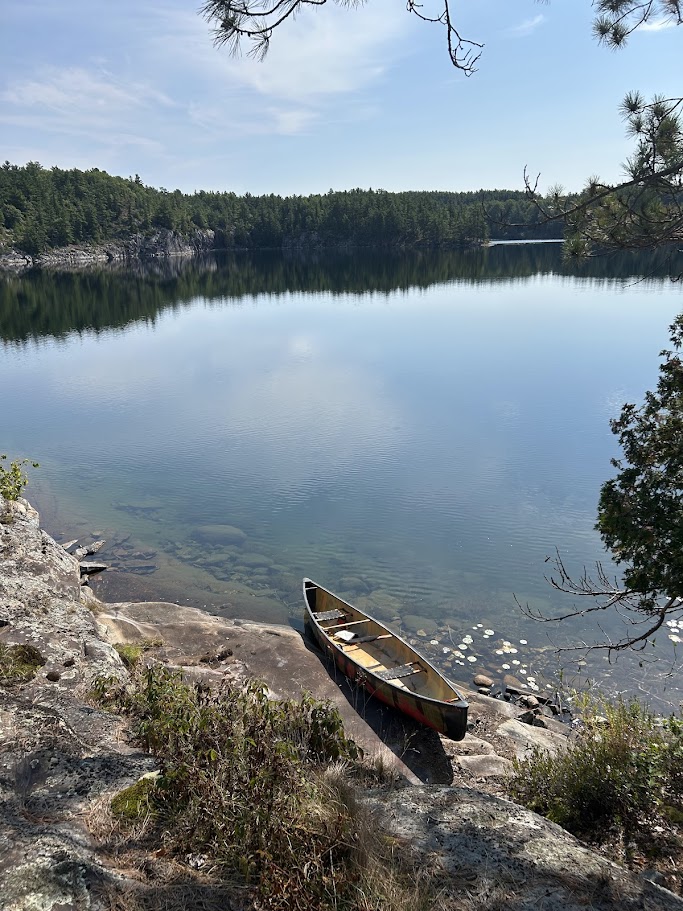
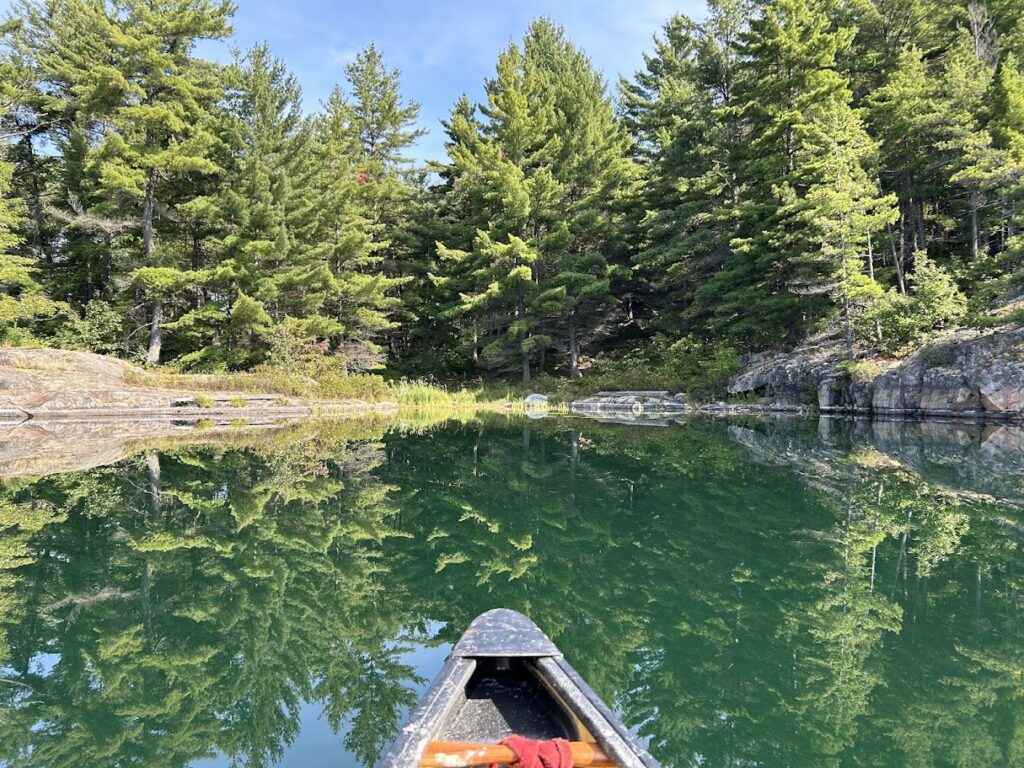
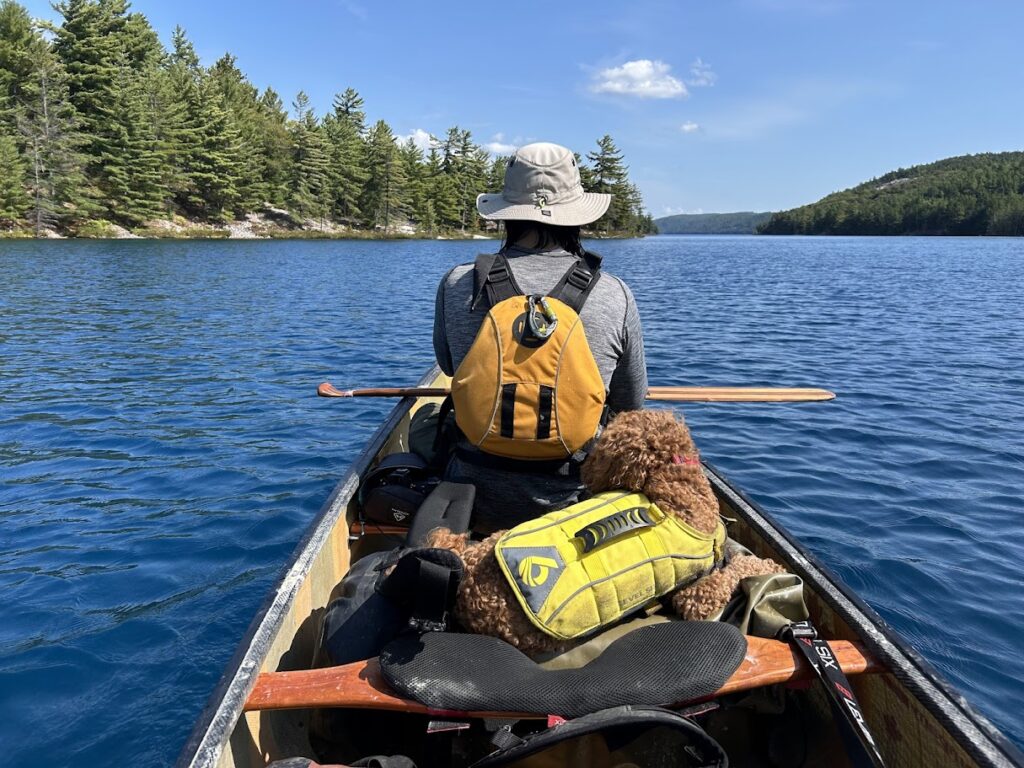
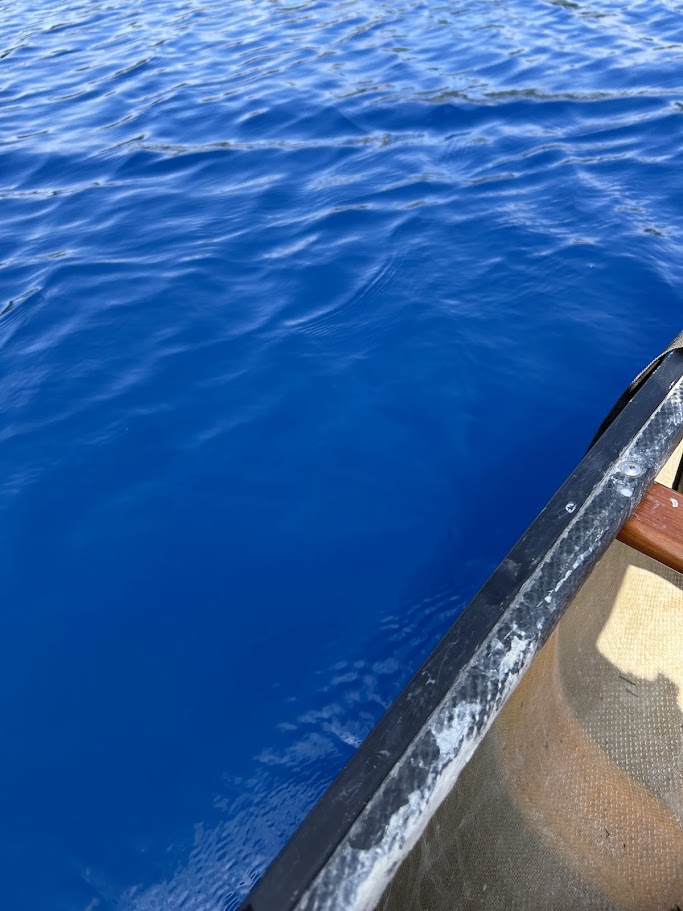
Of the three campsites on Nellie Lake, 206 was hands down the best since it was the furthest into the lake, away from the other sites as well as the other visitors who walk over to look at the lake. (To no surprise, there were many canoes stashed at the portages.)
The campsite was massive and featured a large area where one could clunker down and relax. Being one of the most popular sites in the entire park does have one drawback and that’s with its misuse/overuse. There was some trash, discarded clothing, etc. scattered over the campsite.
Since we arrived at just before 2pm, we had a lot of time to relax and take in the sunlight. For this trip, I brought along my Helinox Chair Zero and using it on this site alone made it worthwhile.
For the first time during this trip, Hana stopped shivering as she found a sunlit patch of grass to sleep on all afternoon.

September 11, 2025
Day 7 – Nellie Lake (#206) to Widgawa Lodge Put-In
Distance Covered : 17.6km
Portages : 2 (2010m, 1660m)
Total Portage Distance : 3670m
Total Time : 4:21hrs
The last day of our trip involved some last minute changes.
The original plan was to do the 1420m portage from Nellie to Murray and retrace our path from day 1.
However, my partner suggested an alternate route which involved going directly west through Grace Lake. I was a little hesitant at first since it involved two portages with over double the distance but agreed to do the new route once he offered to do the longer portage.
In retrospect, it was the right decision since it allowed us to see a new area of the park without any beaver dams.
Much like the first day, we were helped by a slight tailwind which brought us from the last portage on Cranberry Bay to the put-in in less than 2 hours. Around an hour earlier than the estimated arrival using our original route.
The drive back to Toronto was long and tiring but in the end, Hana made up for it in pure theatrics. Upon pulling into my driveway, she nearly ripped the door off of my jeep, sprinted to the front door, and clawed at it desperately as if trying to pry it open. C’mon Hana!!! It wasn’t that bad of a trip was it?!
